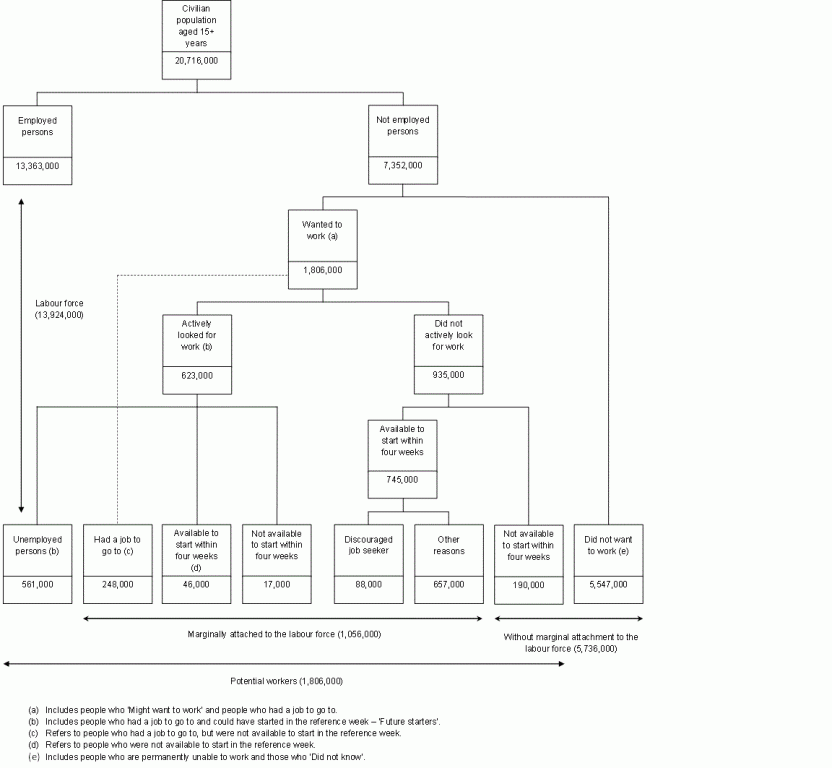Chart 3: Potential workers
[["Feb-15","Mar-15","Apr-15","May-15","Jun-15","Jul-15","Aug-15","Sep-15","Oct-15","Nov-15","Dec-15","Jan-16","Feb-16","Mar-16","Apr-16","May-16","Jun-16","Jul-16","Aug-16","Sep-16","Oct-16","Nov-16","Dec-16","Jan-17","Feb-17","Mar-17","Apr-17","May-17","Jun-17","Jul-17","Aug-17","Sep-17","Oct-17","Nov-17","Dec-17","Jan-18","Feb-18","Mar-18","Apr-18","May-18","Jun-18","Jul-18","Aug-18","Sep-18","Oct-18","Nov-18","Dec-18","Jan-19","Feb-19","Mar-19","Apr-19","May-19","Jun-19","Jul-19","Aug-19","Sep-19","Oct-19","Nov-19","Dec-19","Jan-20","Feb-20","Mar-20","Apr-20","May-20","Jun-20","Jul-20","Aug-20","Sep-20","Oct-20","Nov-20","Dec-20","Jan-21","Feb-21","Mar-21","Apr-21","May-21","Jun-21","Jul-21","Aug-21","Sep-21","Oct-21","Nov-21","Dec-21","Jan-22","Feb-22"],[[97.2],[null],[null],[null],[null],[null],[null],[null],[null],[null],[null],[null],[101.1],[null],[null],[null],[null],[null],[null],[null],[null],[null],[null],[null],[98.2],[null],[null],[null],[null],[null],[null],[null],[null],[null],[null],[null],[98.6],[null],[null],[null],[null],[null],[null],[null],[null],[null],[null],[null],[110.8],[null],[null],[null],[null],[null],[null],[null],[null],[null],[null],[null],[111.5],[null],[null],[null],[null],[null],[null],[null],[null],[null],[null],[null],[119.4],[null],[null],[null],[null],[null],[null],[null],[null],[null],[null],[null],[119.4]],[[264.9],[null],[null],[null],[null],[null],[null],[null],[null],[null],[null],[null],[263.7],[null],[null],[null],[null],[null],[null],[null],[null],[null],[null],[null],[293.5],[null],[null],[null],[null],[null],[null],[null],[null],[null],[null],[null],[284.9],[null],[null],[null],[null],[null],[null],[null],[null],[null],[null],[null],[305.3],[null],[null],[null],[null],[null],[null],[null],[null],[null],[null],[null],[329.9],[null],[null],[null],[null],[null],[null],[null],[null],[null],[null],[null],[339.9],[null],[null],[null],[null],[null],[null],[null],[null],[null],[null],[null],[367.5]],[[715.4],[null],[null],[null],[null],[null],[null],[null],[null],[null],[null],[null],[676.2],[null],[null],[null],[null],[null],[null],[null],[null],[null],[null],[null],[707.1],[null],[null],[null],[null],[null],[null],[null],[null],[null],[null],[null],[691.9],[null],[null],[null],[null],[null],[null],[null],[null],[null],[null],[null],[625.2],[null],[null],[null],[null],[null],[null],[null],[null],[null],[null],[null],[655.5],[null],[null],[null],[null],[null],[null],[null],[null],[null],[null],[null],[760.1],[null],[null],[null],[null],[null],[null],[null],[null],[null],[null],[null],[503.7]],[[1297.2],[null],[null],[null],[null],[null],[null],[null],[null],[null],[null],[null],[1228.1],[null],[null],[null],[null],[null],[null],[null],[null],[null],[null],[null],[1274.4],[null],[null],[null],[null],[null],[null],[null],[null],[null],[null],[null],[1245],[null],[null],[null],[null],[null],[null],[null],[null],[null],[null],[null],[1135.6],[null],[null],[null],[null],[null],[null],[null],[null],[null],[null],[null],[1147.3],[null],[null],[null],[null],[null],[null],[null],[null],[null],[null],[null],[1232.6],[null],[null],[null],[null],[null],[null],[null],[null],[null],[null],[null],[903.1]],[[1626],[null],[null],[null],[null],[null],[null],[null],[null],[null],[null],[null],[1555.4],[null],[null],[null],[null],[null],[null],[null],[null],[null],[null],[null],[1587.2],[null],[null],[null],[null],[null],[null],[null],[null],[null],[null],[null],[1564.9],[null],[null],[null],[null],[null],[null],[null],[null],[null],[null],[null],[1465.3],[null],[null],[null],[null],[null],[null],[null],[null],[null],[null],[null],[1519.8],[null],[null],[null],[null],[null],[null],[null],[null],[null],[null],[null],[1602],[null],[null],[null],[null],[null],[null],[null],[null],[null],[null],[null],[1232]],[[1855.1],[null],[null],[null],[null],[null],[null],[null],[null],[null],[null],[null],[1793.2],[null],[null],[null],[null],[null],[null],[null],[null],[null],[null],[null],[1806.5],[null],[null],[null],[null],[null],[null],[null],[null],[null],[null],[null],[1808.2],[null],[null],[null],[null],[null],[null],[null],[null],[null],[null],[null],[1679.8],[null],[null],[null],[null],[null],[null],[null],[null],[null],[null],[null],[1747.7],[null],[null],[null],[null],[null],[null],[null],[null],[null],[null],[null],[1838.9],[null],[null],[null],[null],[null],[null],[null],[null],[null],[null],[null],[1438.4]],[[2120],[null],[null],[null],[null],[null],[null],[null],[null],[null],[null],[null],[2056.9],[null],[null],[null],[null],[null],[null],[null],[null],[null],[null],[null],[2100],[null],[null],[null],[null],[null],[null],[null],[null],[null],[null],[null],[2093.1],[null],[null],[null],[null],[null],[null],[null],[null],[null],[null],[null],[1985.1],[null],[null],[null],[null],[null],[null],[null],[null],[null],[null],[null],[2077.6],[null],[null],[null],[null],[null],[null],[null],[null],[null],[null],[null],[2178.8],[null],[null],[null],[null],[null],[null],[null],[null],[null],[null],[null],[1805.9]],[[203.7],[151.3],[163.4],[147.5],[139],[154],[177.3],[168.6],[172.8],[169.5],[173.1],[301.5],[190.6],[165.2],[154.4],[164.1],[157.1],[179.2],[186.8],[172.9],[179.5],[185.1],[187.9],[311.3],[218.5],[179],[170.7],[167.6],[168.8],[191.9],[180.6],[153.9],[174.5],[165.4],[174.6],[283.3],[195.1],[170.7],[164],[161.6],[164],[178.3],[188.7],[168.2],[174.8],[192.3],[182.9],[317.2],[203.6],[192.3],[180],[176.3],[186.6],[185.5],[175.4],[182.6],[197.1],[216.1],[208.8],[333.7],[241.1],[189.3],[314.2],[591.7],[439],[362.9],[300.4],[305.9],[290.2],[257.3],[214.9],[357.3],[247.4],[180.6],[202.6],[191.3],[216.5],[244],[382.5],[528.8],[531.8],[279.6],[247.6],[402.9],[266.5]],[[766.2],[760.3],[761.1],[740.7],[749.1],[785.6],[762.7],[773.6],[745.6],[740],[725.8],[764.3],[721.7],[716],[715],[725.7],[721.5],[722.3],[711.2],[714.4],[707.8],[734.6],[745.7],[727.6],[751.8],[754.7],[724.5],[717],[723.3],[724],[718.6],[709.9],[698.8],[711],[739.7],[729],[738.7],[730.5],[732.9],[714.6],[704.1],[699.9],[701.4],[665],[663.9],[682.8],[670.6],[679.6],[669.5],[687.9],[705.4],[707.8],[709],[713.4],[716.8],[707.1],[718.6],[703.2],[690.3],[725.7],[700.4],[719.4],[839],[918.7],[986.4],[1007.5],[921.2],[930.2],[950.2],[939.8],[907.3],[877.8],[804.9],[783.3],[748.1],[703.9],[682.3],[641.1],[620],[628.5],[707.2],[636.5],[576.5],[578.9],[560.4]]]
[]
[{"axis_id":"0","tick_interval":"","axis_min":"","axis_max":"","axis_title":"","precision":-1,"axis_units":"","tooltip_units":"","table_units":"","data_unit_prefix":"","data_unit_suffix":"","reverse_axis":false}][{"value":"0","axis_id":"0","axis_title":"Potential workers ('000)","axis_units":"","tooltip_units":"('000)","table_units":"('000)","axis_min":"0","axis_max":"2500","tick_interval":null,"precision":"1","data_unit_prefix":"","data_unit_suffix":"","reverse_axis":false}]